traction control BUICK PARK AVENUE 1993 Owners Manual
[x] Cancel search | Manufacturer: BUICK, Model Year: 1993, Model line: PARK AVENUE, Model: BUICK PARK AVENUE 1993Pages: 340, PDF Size: 18.17 MB
Page 98 of 340
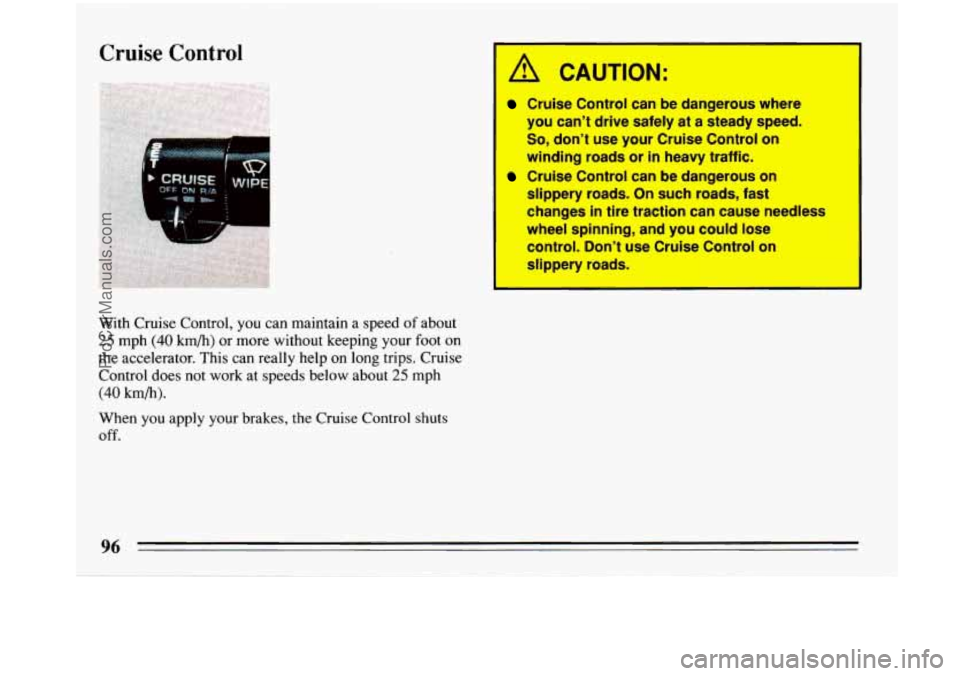
Cruise Control
L .. . .
With Cruise Control, you can maintain a speed of about
25 mph (40 km/h) or more without keeping your foot on
the accelerator. This can really help on long trips. Cruise
Control does not work at speeds below about
25 mph
(40 km/h).
When you apply your brakes, the Cruise Control shuts
off.
A CAUTION:
Cruise Control can be dangerous where
you can't drive safely
at a steady speed.
So, don't use your Cruise Control on
winding roads or in heavy traffic.
Cruise Control can be dangerous on
slippery roads. On such roads, fast
changes
in tire traction can cause needless
wheel spinning, and you could lose
control. Don't use Cruise Control on
slippery roads.
ProCarManuals.com
Page 123 of 340

The anti-lock brake system warning light may also come
on when you are driving with a compact spare tire. If
this happens, the light means you won’t have anti-lock
until you replace the compact spare with a full-size tire.
If the warning light stays on after you replace the
compact spare
with a full-size tire, or if it comes on
again when
you’re driving, your Buick needs service.
Traction Control System Warning Light
(Option)
I The “TRACTION OFF”
warning light means that
the system is not working.
This warning light may
come on for the following
reasons:
If your transaxle overheats, the traction control
system automatically shuts off for about three minutes.
The warning light will come on and stay on
during that time.
If your brakes overheat, the traction control system
will
go off and the warning light will come on until
your brakes cool down.
If the “TRACTION OFF” warning light comes on and
stays on
for an extended period of time, your vehicle
needs service.
A CAUTION:
1 If you let your tires spin at high speed when the
“TRACTION
OFF” warning light is on, they can
explode and you or others could be injured. And,
spinning your tires with the “TRACTION
OFF”
warning light on can cause the transaxle to
overheat or can cause other problems. That
could cause an engine fire or other damage.
When you’re stuck, spin the wheels as little as
possible. Don’t spin the wheels above
35 mph
(55 km/h) as shown on the speedometer.
I
121
ProCarManuals.com
Page 176 of 340

I CAUTION:
Anti-lock doesn’t change the time you need to
get your foot
up to the brake pedal. If you get too
close to the vehicle in front of you, you won’t
have time to
apply your brakes ifethat vehicle
suddenly
stows or stops. Always leave enough
room up ahead to stop, even though you have
antblock brakes.
To Use Anti-Lock:
Don’t pump the brakes. Just hold the brake pedal down
and let anti-lock work for
you.
When you start your vehicle and begin to drive away,
you may hear a momentary motor or clicking noise. And
you may even notice that your brake pedal moves a little
while this is going on. This is the ABS system testing
itself. You may also hear this during a hard stop.
Traction Control System (Option)
Your vehicle may have a traction control system that
limits wheel spin. This is especially useful
in slippery
road conditions. The traction control system works at
low speeds only, such as when you accelerate from a stop. It
applies brake pressure
to an individual wheel
that the system senses is about to spin.
You may feel the system working, or you may notice
some noise, but this is normal.
TRACTION
OFF
The “TRACTION OFF” warning light lets you know if
your traction control system is not working. See
“Traction Control System Warning Light” in the Index.
Disc Brake Wear Indicators
Your Buick has front disc brakes and rear drum brakes.
Disc brake pads have built-in wear indicators that make
a high-pitched warning sound when the brake pads are
worn and new pads are needed. The sound may come
174
ProCarManuals.com
Page 178 of 340
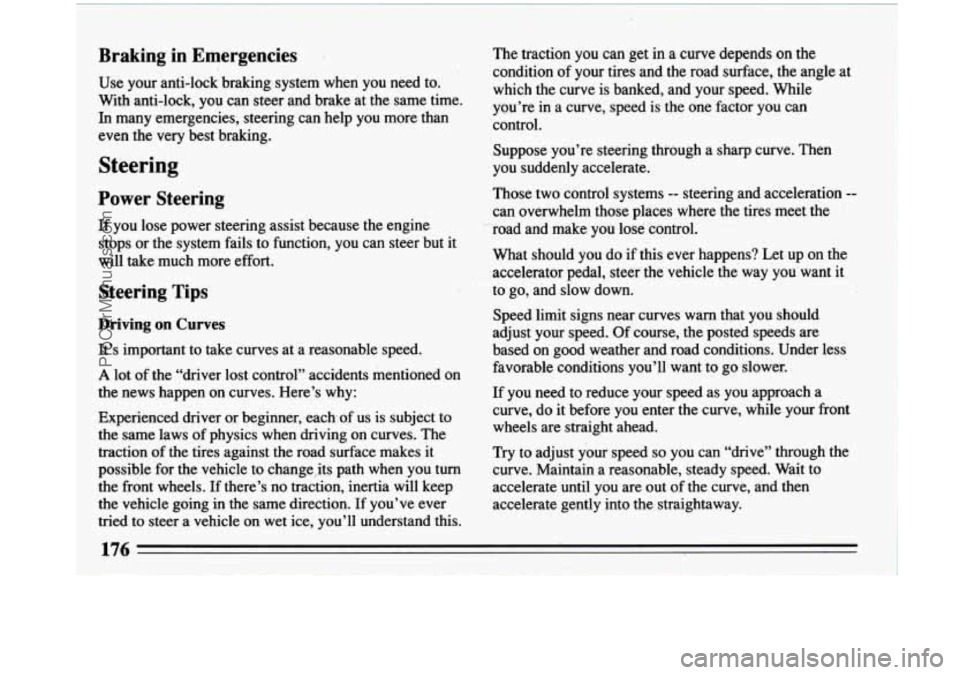
Braking in Emergencies
Use your anti-lock braking system when you need to.
With anti-lock, you ‘can steer and brake at the same time.
In many emergencies, steering can help you more than
even the very best braking.
Steering
Power Steering
If you lose power steering assist because the engine
stops
or the system fails to function, you can steer but it
.will take much more effort.
Steering Tips
Driving on Curves
It’s important to take curves at a reasonable speed.
A lot of the “driver lost control” accidents mentioned on
the news happen on curves. Here’s
why:
Experienced driver or beginner, each.of us is subject to
the same laws of physics when driving on curves. The
traction of the tires against the road surface makes it
possible for the vehicle to changejts path when you
turn
the front wheels. If there’s no traction, inertia will keep
the vehicle going in the same direction. If you’ve ever
tried to steer a vehicle on wet ice, you’ll understand this. The
traction you can get in a curve depends on the
condition of your tires and the road surface, the angle
at
which the curve is banked, and your speed. While
you’re in a curve, speed is the one factor you can
control.
Suppose you’re steering through a sharp curve. Then
you suddenly accelerate.
Those two control systems
-- steering .and acceleration --
can overwhelm those places where the tires meet the
road and make you lose control.
What should you do
if this ever happens? Let up on the
.accelerator pedal, steer the vehicle the way you want it
to go, and slow down.
Speed limit signs near curves
warn that you should
adjust your speed. Of course,
the posted speeds are
based on good weather and road conditions. Under less
favorable conditions you’ll want to go slower.
If you need to reduce your speed as you approach a
curve, do it before you enter the curve, while your front
wheels are straight ahead.
Try to adjust
your speed so you can “drive” through the
curve. Maintain a reasonable, steady speed. Wait to
accelerate until you are out of the curve, and then
accelerate gently into the straightaway.
176 I
ProCarManuals.com
Page 182 of 340
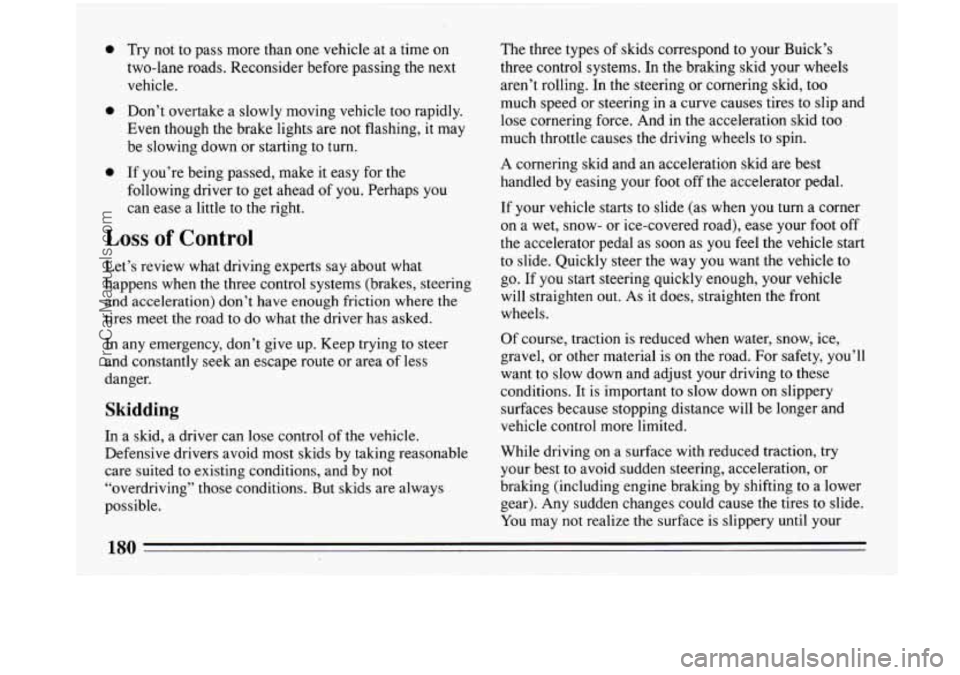
0
0
0
Try not to pass more than one vehicle at a time on
two-lane roads. Reconsider before passing the next
vehicle.
Don’t overtake a slowly moving vehicle too rapidly.
Even though the brake lights are not flashing, it may
be slowing down or starting to turn.
If you’re being passed, make it easy for
the
following driver to get ahead of you. Perhaps you
can ease a little to the right.
Loss of Control
Let’s review what driving experts say about what
happens when the three control systems (brakes, steering
and acceleration) don’t have enough friction where the
tires meet the road to do what the driver has asked.
In any emergency, don’t give up. Keep trying to steer
and constantly seek an escape route or area of less
danger.
Skidding
In a skid, a driver can lose control of the vehicle.
Defensive drivers avoid most skids by taking reasonable
care suited to existing conditions, and by not
“overdriving” those conditions. But skids are always
possible. The three
types of skids correspond to your Buick’s
three control systems. In the braking skid your wheels
aren’t rolling. In
the steering or cornering skid, too
much speed or steering in a curve causes tires to slip and
lose cornering force. And in the acceleration skid too
much throttle causes the driving wheels to spin.
A cornering skid and an acceleration skid are best
handled by easing your foot
off the accelerator pedal.
If your vehicle starts to slide (as when
you turn a corner
on a wet, snow- or ice-covered road), ease your foot off
the accelerator pedal as soon as you feel the vehicle start
to slide. Quickly steer the way you want the vehicle to
go. If
you start steering quickly enough, your vehicle
will straighten
out. As it does, straighten the front
wheels.
Of course, traction is reduced when water, snow, ice,
gravel, or other material is on the road. For safety, you’ll
want to slow down and adjust your driving to these
conditions. It is important
to slow down on slippery
surfaces because stopping distance will be longer and
vehicle control more limited.
While driving on a surface with reduced traction, try
your best to avoid.sudden steering, acceleration, or
braking (including engine braking by shifting to a lower
gear). Any sudden changes could cause the tires to slide.
You may not realize the surface is slippery until your
ProCarManuals.com
Page 276 of 340
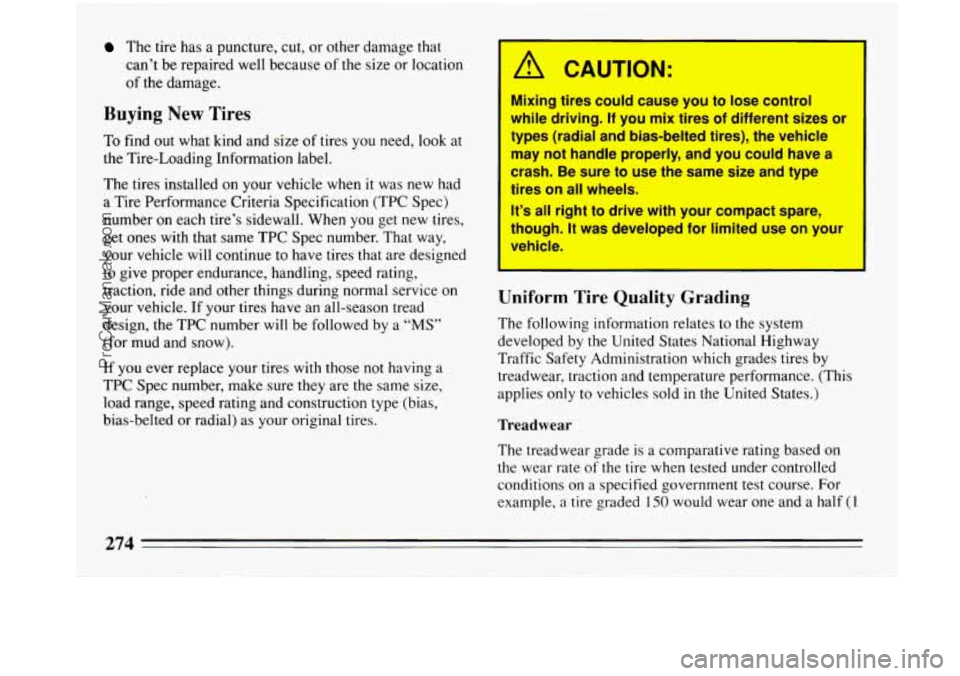
The tire has a puncture, cut, or other damage that
can’t be repaired well because
of the size or location
of the damage.
Buying New Tires
To find out what kind and size of tires you need, look at
the Tire-Loading Information label.
The tires installed
on your vehicle when it was new had
a Tire Performance Criteria Specification (TPC Spec)
number on each tire’s sidewall. When you get
new tires,
get ones with that same TPC Spec number. That way,
your vehicle will continue to have tires that are designed
to give proper endurance, handling, speed rating,
traction, ride and other things during normal service on
your vehicle.
If your tires have an all-season tread
design, the TPC number will be followed by a
“MS”
(for mud and snow).
If you ever replace your tires with those not having a
TPC Spec number, make sure
they are the same size,
load range, speed rating and construction type (bias,
bias-belted or radial) as your original tires.
. CAUTION:
Xing tires could cause you to lose control
hile driving. If you mix tires ob different sizes or
types (radial and bias-betted tires;), the vehicle
may not handle properly, and you coutd have a
crash.
Be sure to use the same size and type
tires on all wheels.
It’s all right to drive
with your compact spare,
bbugh. It was developed for limited use on your
Uniform Tire Quality Grading
The following information relates to the system
developed by the United States National Highway
Traffic Safety Administration which grades tires by
treadwear, traction and temperature performance. (This
applies only to vehicles sold
in the United States.)
Treadwear
The treadwear grade is a comparative rating based on
the wear rate of the tire when tested under controlled
conditions on a specified government test course. For
example, a tire graded
150 would wear one and a half (1
ProCarManuals.com
Page 277 of 340
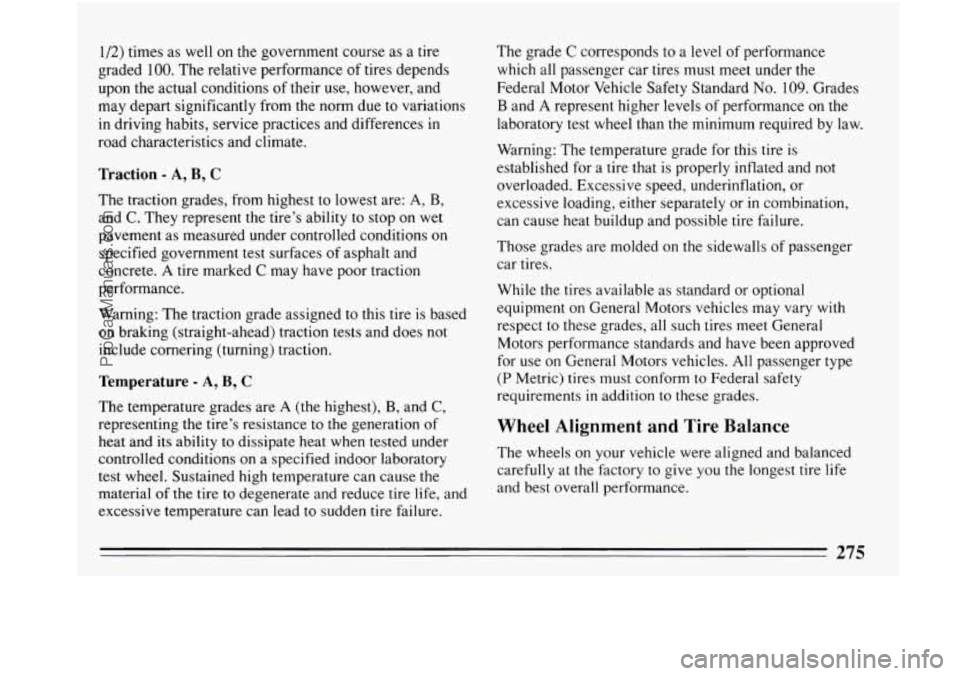
1/2) times as well on the government course as a tire
graded
100. The relative performance of tires depends
upon the actual conditions
of their use, however, and
may depart significantly from the norm due to variations
in driving habits, service practices and differences in
road characteristics and climate.
Traction - A, B, C
The traction grades, from highest to lowest are: A, B,
and C. They represent the tire’s ability to stop on wet
pavement as measured under controlled conditions
on
specified government test surfaces of asphalt and
concrete.
A tire marked C may have poor traction
performance.
Warning: The traction grade assigned to this tire is based
on braking (straight-ahead) traction tests and does not
include cornering (turning) traction.
Temperature - A, B, C
The temperature grades are A (the highest), B, and C,
representing the tire’s resistance to the generation of
heat and its ability
to dissipate heat when tested under
controlled conditions
on a specified indoor laboratory
test wheel. Sustained high temperature can cause the
material of the tire to degenerate and reduce tire
life, and
excessive temperature can lead to sudden tire failure. The grade
C corresponds to a
level of performance
which all passenger car tires must meet under the
Federal Motor Vehicle Safety Standard
No. 109. Grades
B and A represent higher levels of performance on the
laboratory test wheel than the minimum required by law.
Warning: The temperature grade for this tire is
established for a tire that is properly inflated and not
overloaded. Excessive speed, underinflation, or
excessive loading, either separately or in combination,
can cause heat buildup and possible tire failure.
Those grades are molded on the sidewalls
of passenger
car tires.
While the tires available as standard or optional
equipment on General Motors vehicles may vary with
respect to these grades, all such tires meet General
Motors performance standards and have been approved
for use on General Motors vehicles. All passenger type
(P Metric) tires must conform to Federal safety
requirements
in addition to these grades.
Wheel Alignment and Tire Balance
The wheels on your vehicle were aligned and balanced
carefully at the factory to give you the longest tire life
and best overall performance.
275
ProCarManuals.com
Page 333 of 340
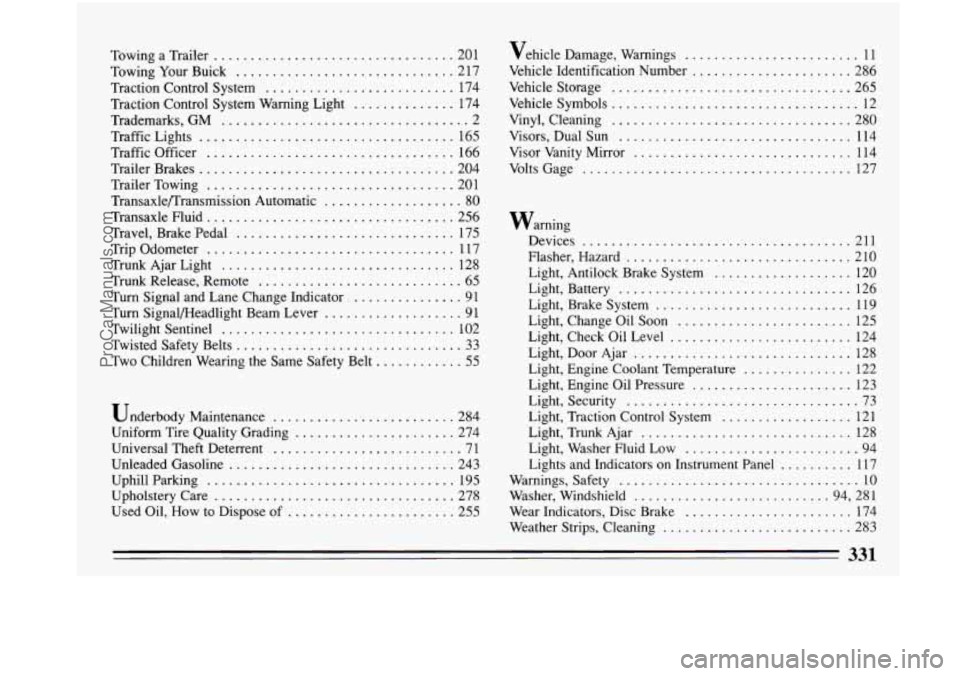
Towing a Trailer ................................. 201
Towing Your Buick
.............................. 2 17
Traction Control System
.......................... 174
Traction Control System Warning Light
.............. 174
Trademarks. GM
.................................. 2
Traffic Lights
................................... 165
Traffic Officer
.................................. 166
Trailer Brakes
................................... 204
Trailer Towing
.................................. 201
Transaxleflransmission Automatic
................... 80
Transaxle Fluid
.................................. 256
Travel. Brake Pedal
.............................. 175
Trip Odometer
.................................. 117
Trunk Ajar Light
................................ 128
Trunk Release. Remote
............................ 65
Turn Signal and Lane Change Indicator
............... 91
Tun Signalmeadlight Beam Lever
................... 91
Twilight Sentinel ................................ 102
Twisted Safety Belts
............................... 33
Two Children Wearing the Same Safety Belt
............ 55
Underbody Maintenance
......................... 284
Uniform Tire Quality Grading
...................... 274
Universal Theft Deterrent
.......................... 71
Unleaded Gasoline
............................... 243
Uphill Parking
.................................. 195
Upholstery Care
................................. 278
Used Oil. How to Dispose
of ....................... 255 Vehicle
Damage. Warnmgs
........................ 11
Vehicle Identification Number
...................... 286
Vehicle Storage
................................. 265
Vehicle Symbols
.................................. 12
Vinyl. Cleaning
................................. 280
Visors. Dual Sun
................................ 114
Visor Vanity Mirror
.............................. 114
VoltsGage
..................................... 127
Warning Devices 211
Flasher. Hazard
............................... 210
Light. Antilock Brake System
................... 120
Light. Battery
................................ 126
Light. Brake System
........................... 119
Light. Change Oil Soon
........................ 125
Light. Check Oil Level
......................... 124
Light. Door Ajar
.............................. 128
Light. Engine Coolant Temperature
............... 122
Light. Engine Oil Pressure ...................... 123
Light. Security
................................ 73
Light. Traction Control System
.................. 121
Light. Trunk Ajar
............................. 128
Lights and Indicators on Instrument Panel
.......... 117
Warnings. Safety
................................. 10
Washer. Windshield
........................... 94. 281
Wear Indicators. Disc Brake
....................... 174
Weather Strips. Cleaning
.......................... 283
.
.....................................
Light. Washer Fluid Low ........................ 94
331
-. _..L.^L... .. .... ......... ~~ ...... . . ... -._e-
ProCarManuals.com